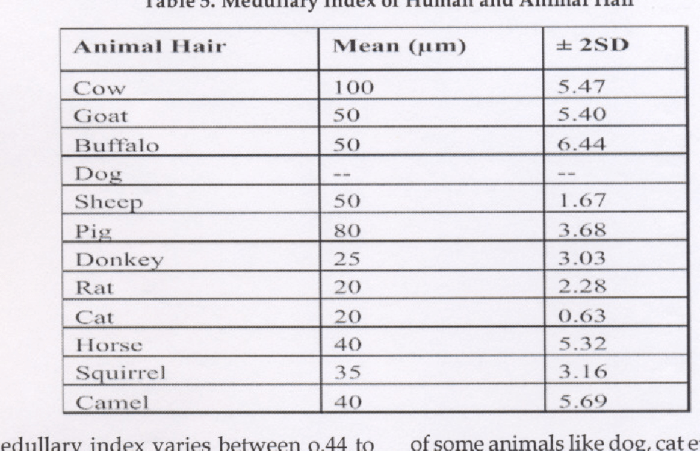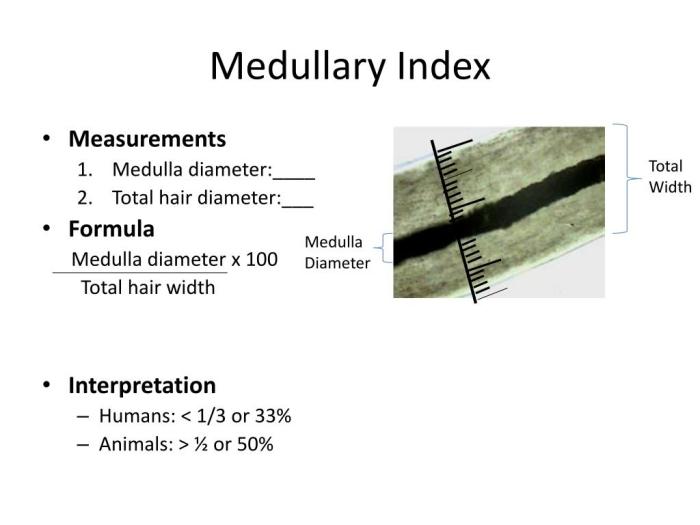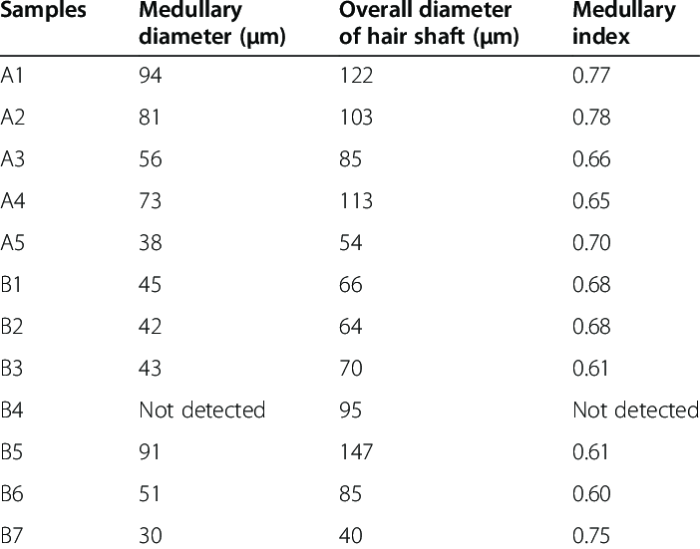The medullary index of human hair, a captivating measure of its inner structure, unveils a fascinating tale of genetic diversity, forensic intrigue, and anthropological insights. From its role in unraveling the mysteries of hair growth to its significance in forensic investigations, the medullary index weaves a captivating narrative that will leave you intrigued.
Delving into the intricate world of hair biology, we will explore the factors that shape the medullary index, unravel its relationship with hair characteristics, and uncover its potential applications in medicine, cosmetics, and beyond.
Definition and Measurement of Medullary Index

The medullary index is a measure of the relative width of the medulla, the central core of the hair shaft. It is expressed as a percentage of the total hair shaft diameter.
The medullary index is determined by measuring the width of the medulla and the total hair shaft diameter using a microscope. The medullary index is calculated using the following formula:
Medullary index = (Medulla width / Total hair shaft diameter) x 100
Methods for Measuring Medullary Index
There are two main methods for measuring the medullary index: the longitudinal method and the cross-sectional method.
The medullary index of human hair is a valuable indicator of hair characteristics. To determine significant differences between two groups of medullary index data, researchers often employ the Wilcoxon rank-sum test in Excel. This non-parametric test is particularly useful when the data distribution is not normal, enabling researchers to analyze the medullary index of human hair accurately and reliably.
- Longitudinal method:This method involves measuring the width of the medulla and the total hair shaft diameter along the length of the hair shaft.
- Cross-sectional method:This method involves measuring the width of the medulla and the total hair shaft diameter in a cross-section of the hair shaft.
The longitudinal method is more accurate than the cross-sectional method, but it is also more time-consuming.
Variation in Medullary Index

The medullary index is not a constant value and can vary within and between individuals. This variation is influenced by several factors, including age, sex, hair color, and ethnicity.
Generally, the medullary index tends to decrease with age. This is because the hair shaft becomes thinner and the medulla becomes less prominent as we get older. Sex also plays a role, with males typically having a higher medullary index than females.
Geographical and Ethnic Variations
In addition to individual variation, the medullary index also varies geographically and ethnically. For example, people of African descent tend to have a higher medullary index than people of European descent. This is likely due to differences in hair structure and genetics.
The medullary index can also vary within a single population. For example, a study of people from the United States found that the medullary index was higher in people from the southern United States than in people from the northern United States.
Medullary Index and Hair Characteristics

Medullary index provides insights into various hair characteristics. Understanding the relationship between medullary index and other hair attributes can help determine hair growth patterns, hair health, and hair type.
Hair Diameter
Hair with a high medullary index tends to have a larger diameter. This is because the medulla, the innermost layer of the hair shaft, contributes to the overall thickness of the hair. Hair with a thicker medulla will appear coarser and more voluminous.
Hair Color
Medullary index can also influence hair color. Hair with a high medullary index often appears darker due to the presence of more melanin pigments in the medulla. These pigments absorb and reflect light, giving the hair a darker hue.
Hair Texture
Medullary index plays a role in determining hair texture. Hair with a high medullary index tends to be more porous and prone to frizz. This is because the larger medulla allows moisture to penetrate the hair shaft more easily, leading to hair that is more prone to becoming dry and frizzy.
Medullary Index in Forensic Science

The medullary index plays a significant role in forensic hair analysis. It aids in the identification of individuals and the determination of the origin of hair samples.
Identifying Individuals
The medullary index can be used to differentiate between individuals. Individuals have unique medullary index values, which can be used to create a database for comparison. When a hair sample is found at a crime scene, its medullary index can be compared to the database to identify potential suspects.
Determining Hair Origin, Medullary index of human hair
The medullary index can also help determine the origin of hair samples. Different ethnic groups have characteristic medullary index ranges. By comparing the medullary index of a hair sample to known ranges, forensic scientists can infer the possible origin of the hair.
Medullary Index and Anthropology
The medullary index plays a significant role in anthropological studies as it offers valuable insights into human evolution and population genetics. By analyzing the medullary index of individuals or populations, anthropologists can gain a better understanding of their genetic makeup and evolutionary history.
Medullary Index and Human Evolution
The medullary index has been used to study the evolutionary relationships between different human populations. Researchers have found that populations from different geographic regions tend to have distinct medullary index values. For example, populations from East Asia generally have a lower medullary index compared to populations from Africa.
By comparing the medullary index of different populations, anthropologists can infer patterns of human migration and genetic exchange over time. This information can help us understand how human populations have evolved and adapted to different environments.
Medullary Index and Population Genetics
The medullary index can also provide insights into the genetic diversity within a population. Populations with a high degree of genetic diversity tend to have a wider range of medullary index values. This is because genetic diversity leads to variations in hair characteristics, including the size and shape of the medulla.
By studying the medullary index distribution within a population, anthropologists can gain information about the genetic relationships between individuals and the level of gene flow within the population. This information can be used to identify isolated populations, study the effects of inbreeding, and assess the genetic health of a population.
Research and Applications

Research on medullary index continues to advance, shedding light on its potential applications in various fields.
In medicine, medullary index has been investigated for its role in hair growth and disorders. Studies have shown that individuals with certain hair disorders, such as alopecia areata, may have altered medullary index patterns.
Cosmetics
The cosmetics industry is exploring the use of medullary index to assess hair health and damage. By measuring the medullary index of hair samples, cosmetic companies can develop products that target specific hair concerns, such as dryness, breakage, or color fading.
Textile Industry
The textile industry is also showing interest in medullary index. The medullary index of fibers can influence their properties, such as strength, elasticity, and dye absorption. By understanding the medullary index of different fibers, textile manufacturers can optimize their production processes and create fabrics with desired characteristics.
FAQ Compilation: Medullary Index Of Human Hair
What is the medullary index?
The medullary index is a measure of the width of the medulla, the innermost layer of the hair shaft, relative to the overall hair diameter.
How is the medullary index measured?
The medullary index is typically measured using a microscope to examine cross-sections of hair shafts.
What factors influence the medullary index?
The medullary index can be influenced by genetics, age, sex, ethnicity, and environmental factors.
What is the significance of the medullary index in forensic science?
The medullary index can be used to identify individuals and determine the origin of hair samples in forensic investigations.
What is the role of the medullary index in anthropology?
The medullary index can provide insights into human evolution and population genetics.